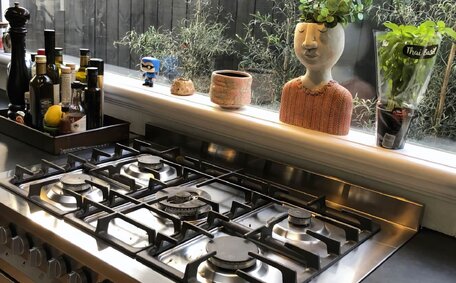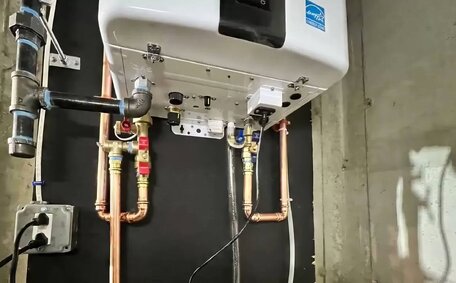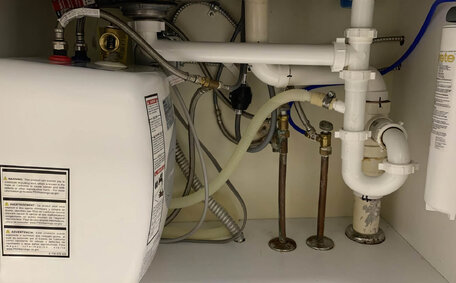Overview of Pipe Relining and Materials Used
Pipe and denture relining share a common goal: a trenchless method of repairing from the inside out, restoring structural integrity and preventing leaks without excavation. The process involves inserting a resin-impregnated liner, akin to a denture base, into the existing pipe, which is then cured to form a smooth, seamless new pipe within the old one.
Relining eliminates the need to dig up pipes, reducing disruption and cost.
At Strathfield Plumbing Services, we use advanced CIPP (cured-in-place pipe) and liner denture materials like ceramic epoxy, epoxy resin, glass-reinforced epoxy, polyethylene and PVC. These high-tech materials allow pipes to be restored even around tight bends. Their heat or UV light-cured properties give them excellent adhesion, durability and corrosion resistance.
The relining process can extend the lifespan of pipes by 50 years or more. It’s suitable for all common pipe materials like concrete, clay, galvanised steel and cast iron. We use it to reline sewer, stormwater and drainage pipes up to 600mm diameter, without excavation or disruption to your property or landscaping.
In the sections below, we’ll explore the various relining materials available and their specific properties and applications in plumbing and denture restoration.
Safety Considerations for Potable Water Pipe Relining
When relining pipes carrying drinking water, it is crucial to use materials that are certified safe and non-toxic. Compliance with Australian standard AS/NZS 4020 ensures products do not leach chemicals or impact water quality. Liquid epoxy has been extensively tested and approved for contact with potable water in residential buildings.
At Strathfield Plumbing Services, we only use high-grade resin systems from reputable suppliers that meet all health and safety regulations. CIPP liners containing styrene are never used for potable water applications. The relining materials are inert once cured and provide a smooth, chemically-resistant new pipe that maintains water purity.
By selecting the appropriate relining products, we can restore old pipes delivering long-term performance without compromising safety. Our expertise in material selection for potable water systems ensures peace of mind for homeowners.
Common Pipe Relining Materials
There are several materials commonly used for relining pipes, each with their own properties, advantages and ideal applications:
Ceramic Epoxy
A two-part epoxy blended with ceramic elements for enhanced strength and heat resistance. It offers excellent adhesion, abrasion resistance and long term stability suitable for high pressure, temperature or chemical exposure applications.
Pros: Withstands temperatures up to 150°C. Highly durable and corrosion proof.
Cons: Rigid with low flexibility. Higher cost than other epoxies.
Applications: Industral pipelines, sewer lines, chemical drainage.
Cured-In-Place Pipe (CIPP) Liners
A resin-saturated felt tube inserted into the damaged pipe then cured with hot water or steam to form a tight-fitting, jointless new pipe within.
Pros: Conforms smoothly around bends and fittings. Seamless, watertight and corrosion proof. Long lifespan.
Cons: Rigid with no flexibility. Suitable for straight pipe sections.
Applications: Potable water, gas lines, general plumbing and drainage.
A two-part thermosetting resin that cures when mixed with a catalyst/hardener. Offers excellent adhesion and chemical resistance.
Pros: Cost effective material. Long lasting with good fatigue strength. Non toxic when cured.
Cons:Slow cure time. Requires dry surface for application.
Applications: General potable water plumbing, sewer repairs.
The right relining product depends on the pipe system, pressure, flow rate and liquid transported. Our experts evaluate each project to select suitable materials for long lasting, safe restorations.
Epoxy Resin
Epoxy resin is commonly used as the raw material in many CIPP liners for pipe relining. It is a two-part polymer compound consisting of an epoxy base resin and a curing agent or hardener. When combined, these form a tough, adhesive material that cures to an inert, stiff plastic highly resistant to chemicals and corrosion.
Epoxy resin offers numerous benefits that make it ideal for restoring old pipes:
- Strong adhesion allows it to bond firmly to the interior walls of a damaged pipe.
- Excellent resistance to acids, alkalis, salts and organic solvents once fully cured.
- Withstands continuous temperatures up to 90°C.
- High strength and long term stability.
- Low shrinkage minimises loss of volume during curing.
The resin-saturated liner conforms smoothly to bends and fittings for seamless pipe remediation. It provides a durable solution that can extend the life of a pipe system for decades. Epoxy CIPP liners are regularly used in sewer and stormwater drain repairs due to this longevity and reliable performance.
At Strathfield Plumbing Services, we rely on quality epoxy resins to restore pipes and prevent further deterioration or leaks. Its versatility across applications makes it our top choice for residential and commercial relining projects.
Polyethylene
Polyethylene (PE) is another polymer material that can be used to reline pipes due to its flexibility, durability and chemical resistance. As a thermoplastic, PE liners can be heated and formed into the exact shape required to fit existing pipes.
Key properties of polyethylene pipe liners include:
- High flexibility - Can stretch around bends and corners in pipe systems.
- Impact strength - Withstands moderate blows without cracking or splitting.
- Stress crack resistant - Suitable for transporting some chemicals and solvents.
- Corrosion proof - Provides protection for ageing metal pipes.
- Cost effective relining option.
Polyethylene liners are suitable for use in stormwater, sewage, gas and general plumbing applications. They can withstand exposure to moisture, acids and alkalis. PE offers good flow efficiency due to its smooth surface.
Here at Strathfield Plumbing Services, we recommend polyethylene pipe lining for cold water applications up to 40°C. Polyethylene gives a long service life span for restored pipes at a reasonable upfront cost.
Glass Reinforced Epoxy
Glass reinforced epoxy (GRE) liners provide extreme strength and durability for structurally damaged pipes. They contain fine glass fibres bonded into the epoxy resin matrix, significantly increasing its strength, stiffness and resistance to both pressure and vacuum.
The addition of glass fibres enables this material to withstand substantial physical stresses. GRE liners have a very high strength-to-weight ratio, making them suitable for reinforcing pipes under heavy loads or external pressures. They are also excellent at transferring structural loads from weakened sections of old pipes to intact areas.
We recommend glass reinforced epoxy relining for severely degraded pipes that require reconstruction and reinforcement for continued use. The material is ideal where there is a risk of collapse due to loss of pipe wall thickness. It can restore integrity to sewer lines with extensive corrosion, structural cracks or damaged joints.
The enhanced epoxy resin provides the usual properties of liquid-tight sealing, chemical resistance and temperature tolerance up to 90°C. By integrating high strength glass reinforcement, GRE liners restore pipes to full operational capacity, drastically extending service life at a fraction of replacement costs.
Effectiveness and Longevity of Pipe Relining Materials
Pipe relining using epoxy resins and other polymeric materials provides an extremely effective and long-lasting alternative to full pipe replacement. Studies show properly installed relining systems have an average service life of 50+ years.
Factors that influence longevity include:
- Pipe condition assessment - Thorough pre-inspection ensures suitable materials and liner thickness.
- Experienced installers - Proper impregnation and curing of liners.
- Quality materials – Using reputable epoxy resins or PE/PVC thermoplastics.
Relined pipes provide enhanced flow rates, pressure capacities, chemical resistance and structural integrity equivalent to new pipes. The process uses minimal water and energy compared to traditional dig-and-replace methods, making it over 90% more eco-friendly.
We find pipe relining reduces costs by 50-80% compared to full replacement. It prevents expensive excavation work which would damage gardens and landscaping. Overall, epoxy and polymer relining materials give exceptional value for money with impressive longevity.
Step-by-Step Pipe Relining Process
Relining a pipe is a complex process requiring expertise and precision at every step. Here is an overview of our professional grade pipe relining procedure:
- Site Inspection - We perform a detailed video inspection using CCTV cameras to evaluate pipe condition, diameter, materials, bends and access points.
- Pipe Preparation - The line is drained and cleaned thoroughly by high pressure water jetting. All debris, deposits, roots and intrusions are removed.
- Drying & Curing - Hot compressed air is blown through the pipe to remove all moisture. This step is critical for epoxy resin liners which require a dry bonding surface.
- Resin Impregnation - The custom-sized CIPP or polyethylene felt liner tube is vacuum-impregnated with liquid epoxy resin or PVC. The liner may include fibre reinforcements.
- Installation - Using a mechanical pull winch and guide rollers, the resin-saturated liner is pulled into position inside the original pipe.
- Curing Process - Liners are cured using hot water under hydrostatic pressure or steam to activate the thermosetting resin. Curing times vary from 1-6 hours.
- Cool Down & Finish - The new lined pipe is cooled, set hard then trimmed flush at entry points. Lateral connections are reopened using a robotic cutter.
- Post-Inspection - We thoroughly inspect the reinstated pipe using CCTV and test for leaks to ensure integrity.
When performed by trained technicians using quality materials, pipe relining is a highly effective trenchless repair method providing long-term functionality.
Cost and Environmental Benefits of Pipe Relining
Pipe relining provides substantial cost savings compared to full pipe replacement. Short term costs can be 60-80% less as it eliminates expensive excavation, repairing landscapes or driveways, and installing new pipe sections.
Over the long run, pipe relining extends asset lifespan by 50+ years. Amortised over that period, it works out much cheaper than replacing pipes every 20-30 years. There are also minimal ongoing costs as relined pipes have better flow rates and require less maintenance.
Environmental benefits include:
- Reduced landfill waste - Old pipes remain underground so no concrete, iron, PVC or other piping ends up as landfill.
- Lower carbon emissions - The relining process consumes far less energy than manufacturing and transporting new pipe materials.
- Less water wastage - No water loss from drainage/water supply during open trenches.
- Preservation of soils and vegetation - Trenchless methods avoid damage to trees, plants and soil ecology.
Pipe relining ticks all the boxes for sustainable, low impact pipe remediation. We consider its environmental credentials a major plus for councils and contractors seeking green alternatives.
In summary, pipe relining offers major cost and ecological advantages over replacement. Contact Strathfield Plumbing to learn how it can save you money while benefiting the environment.






